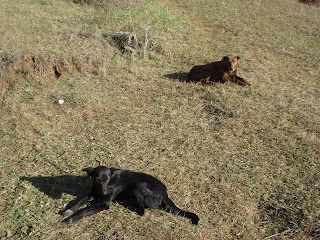Chuchos. Just when you think you have them figured out, they flip it on you. If you refer to one of my first blogs, I declared my undying dislike for Guatemalan dogs after a near death (ok, a slight exaggeration) experience with a couple particularly ferocious ones in Santa Maria Cauque. In my town, over the past 14 months, I've come to a conclusion. Chuchos, aka the dogs of Guatemala that claim no real home and just wander the street, are not the bad ones. These dogs are basically in just survival mode, scavenging what they can to get by and can even provide an occasional laugh when they are seen stuck together after a little baby chucho making-always with an incredibly guilty look on their faces as they stroll along attached end to end. The dogs that are the real culprits in Guatemala are the ones which are actually owned by people, who keep them close to the house and often on very short chains so that when they are released they are very aggressive and want to attack anything that moves. Guatemalans encourage their dogs to be aggressive as a deterrent to intruders, but the dogs will attack anyone who happens to pass within 50 yards of the house. These dogs are the ones who need to be eliminated.
With that said, since about last September, I've had a couple of local chuchos that scavenge around my house. One of them, who Katie named Mama Bear, showed up with a huge wound on her back, what looked like a possible machete wound. This wouldn't be completely out of the question; Guatemalans can be pretty cruel to animals, especially dogs that they don't want around. When Mama Bear had this wound, she also had some super saggy milkers hanging down-a single mother who was being abused. She was a pretty sympathetic figure and I started giving her my leftovers. Soon enough, one of her puppies started coming around with her and she was christened Blacky by me-Katie's a bit more creative than I am.

Majestic Mama Bear.

Blacky licking her chops.
Well, Mama Bear and Blacky have been hanging around ever since, eating my leftovers and chasing off other dogs that come around. I've discovered that chuchos will eat bananas, avocados, oatmeal and almost anything you put in front of them. They've become my buddies and lately have started to let me pet them. They don't understand fetch and whenever I throw food for them to catch in their mouth it usually just bounces off their nose. They mostly just want to lie back and have their bellies rubbed. They're good to have around though and have forever altered my view of chuchos for the better.





